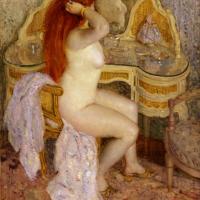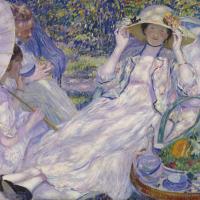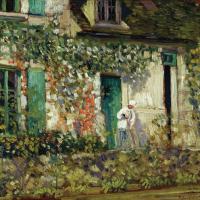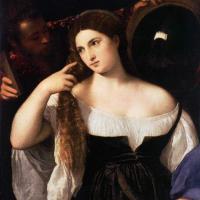Frederick Carl Frieseke
Afternoon Yellow Room
$510.00
The Hour Of Tea
$480.00
The House In Giverny
$450.00
The Robe
$450.00
Woman With A Mirror
$510.00
Frederick Carl Frieseke
Frederick Carl Frieseke (1874-1939)
Frederick Carl Frieseke (April 7, 1874 – August 24, 1939) was an American Impressionist painter who spent most of his life as an expatriate in France. An influential member of the Giverny art colony, his paintings often concentrated on various effects of dappled sunlight. He is especially known for painting female subjects, both indoors and out.
Starting in 1899, just over a year since his arrival in Paris, Frieseke exhibited at the Salon of the Société Nationale des Beaux-Arts.
Whistler's influence is evident in Frieseke's early mature paintings, with close tonalities. By his post-1900 work, his palette had evolved toward that of the Impressionists, becoming light and colorful; however, he still retained the strong linear customs of art back in the United States.
In the summer of 1905, he spent at least a month in the Giverny art colony. In October of that year he married Sarah Anne O'Bryan (known as Sadie), whom he had met seven years earlier. Frieseke and his wife (and later, their daughter) spent every summer from 1906 to 1919 in Giverny. He kept a Paris apartment and studio throughout his life, and the Friesekes spent the winters in Paris. Their Giverny house, previously the residence of Theodore Robinson, was next door to Claude Monet's. Despite the proximity, Frieseke did not become close friends with Monet, nor was Monet an artistic influence. He said in an interview, "No artist in [the impressionist] school has influenced me except, perhaps, Renoir.” Indeed, Frieseke's paintings of sensually rounded figures often bear a resemblance to those of Pierre-Auguste Renoir.
The Friesekes' Giverny home and the garden they created there were often featured in his paintings, and his wife would frequently pose for him. He also kept another studio nearby on the Epte river. Many of his outdoor nudes were painted there.
After spending some time in Giverny, his unique style quickly emerged, and he would be quite influential with most of the other members of the colony. Although well known as an Impressionist, some of his work, with its "intense, almost arbitrary colors", demonstrates the Post-Impressionist influence of artists Paul Gauguin and Pierre Bonnard. The term "Decorative Impressionism" was coined by an art writer to refer to Frieseke's style. It combined the decorative style of Les Nabis, expressively using color and pattern, with classic Impressionist interests in atmosphere and sunlight.
He was very interested in rendering sunlit subjects on canvas, saying, "It is sunshine, flowers in sunshine; girls in sunshine; the nude in sunshine, which I have been principally interested in. If I could only reproduce it exactly as I see it I would be satisfied.” However, his interpretation of sunshine often did not appear natural. According to a recent observer, "His light hardly seems to be plein air light at all. In fact it seems entirely artificial ... a stunning concoction of blues and magentas frosted with early summer green and flecks of white."
The prestigious Venice Biennale featured seventeen Frieseke paintings in 1909.
Frieseke's artistic influence was greatly felt among the Americans in Giverny, most of whom shared his Midwestern background and had also begun their art studies in Chicago. Among those artists were Louis Ritman, Karl Anderson, Lawton Parker, and Karl Buehr.
Frieseke preferred the attitudes in France over those which he encountered in the United States: "I am more free and there are not the Puritanical restrictions which prevail in America – here I can paint the nude out of doors." He found the American attitudes to be frustrating, but occasionally a source of amusement. While on his first visit back home in Owosso in 1902, Frieseke wrote, "I get much pleasure in shocking the good Church people with the nudes".
The Friesekes' only child, daughter Frances, was born in 1914. In 1920 Frieseke and his family moved to a farm in Le Mesnil-sur-Blangy, Normandy. His art of this period concentrated on female figures, particularly nudes. While developing a more modern style, he included historical and contemporary references. He used a darker color palette and limited his use of surface patterns. In these works, his interest in chiaroscuro may be discerned.
In 1923 he left the Salon of the Société Nationale des Beaux-Arts and co-founded, with other artists, the Salon des Tuileries. He resumed painting in watercolors, especially while on trips to Nice in the winter and during a 1930 to 1932 visit to Switzerland.
Frieseke had established a superb reputation during his career. A 1931 book refers to Frieseke as "one of the most prominent members of our self-exiled Americans." He died in his Normandy home on August 24, 1939, of an aneurysm.
He won many awards during his career. In 1904 he received a silver medal in St. Louis at the Louisiana Purchase Exposition and was awarded a gold medal at the Munich International Art Exposition. He was honored with the William A. Clark Prize at the Corcoran Gallery of Art's 1908 biennial, and the Temple Gold Medal in the Pennsylvania Academy of the Fine Arts' annual exhibition of 1913. One of his greatest honors was winning the Grand Prize at the Panama–Pacific International Exposition, which was held in San Francisco in 1915. Among his entries was Summer, now at the Metropolitan Museum of Art. The New York Timesproclaimed in June 1915: "Mr. Frieseke, whose accomplished work is well known to New Yorkers, says the last word in the style that was modern before the Modernists came along. Whatever he does has a sense of design, color, and style. A sense of gayety, an entertaining and well considered pattern, a remarkable knowledge of the effect of outdoor light on color are found in nearly all of his most recent paintings."
He received two gold medals from the Art Institute of Chicago in 1920 and he also won the popular prize, decided by artists as well as the viewing public.
Frieseke was elected an Associate of the National Academy of Design (ANA) in 1912, and an Academician (NA) in 1914. He was decorated as a Chevalier of the French Legion of Honour in 1920, a rare recognition for an American painter.








